|
Greetings, and welcome to the September 2019 edition of FGS News and Research. It has been a busy summer at FGS. We are excitedly gearing up for our annual Earth Science Week Open House on November 1. We look forward to partnering with WaterVentures Learning Lab during the event. We would love to see all of you there, and I encourage you to share this wonderful learning opportunity with family, colleagues, and friends.
Both fossil enthusiasts and Game of Thrones fans will enjoy learning what fossil records of dire wolves tell us about this prehistoric animal in this issue’s Geofact. Explore the geologic wonders of Windley Key State Park, and our Featured Formation - the Bridgeboro Limestone. This issue also covers geoscience mentoring as well as a recent trip to Montana by two of our geologists to attend the annual Digital Mapping Techniques Workshop. The meeting brought together GIS specialists, geoscientists, and cartographers from government and private sectors to exchange ideas about geologic mapping.
Finally, the FGS recently wished a fond farewell to Professional Geologist Dan Phelps. Dan served as a geologist at FGS for 17 years and worked 29 years with the Florida Department of Environmental Protection, and we wish him nothing but good health and happiness in his retirement. I invite you to learn more about Dan’s career in this issue.
Sincerely,
 Jonathan D. Arthur, Ph.D., P.G.
Director and State Geologist
Florida Geological Survey
Florida Department of Environmental Protection


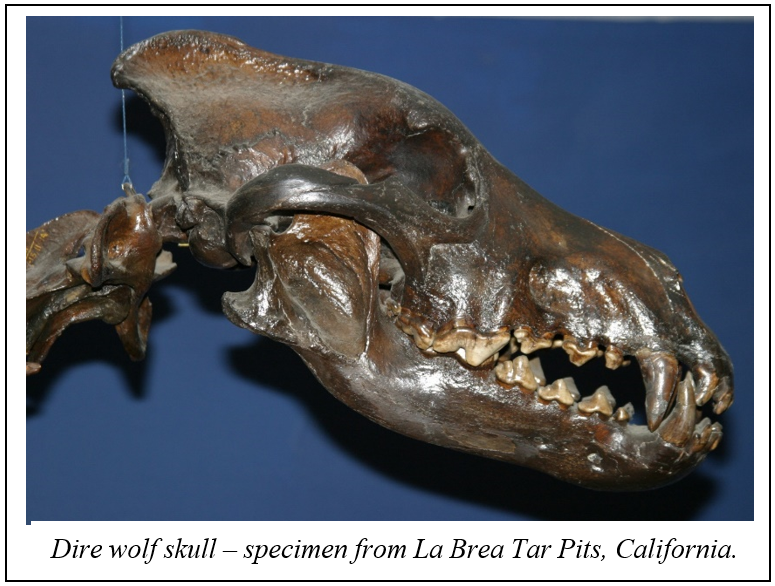
The HBO series Game of Thrones is one of the most popular TV programs of all time. Mythical creatures and spectacular scenery were part of the reason for the show’s popularity. Dragons and giants were integral fictional characters in the series. Did you know, however, that one of the creatures was actually based on a fossil animal that roamed prehistoric North America, including Florida? Although the actual fossil record indicates that these animals were somewhat smaller than the dire wolves that protected the Stark children, measurements taken from fossil remains indicate that these formidable predators weighed between 130 and 150 pounds.
Dire wolves belong to the family Caninae, and members of this family are collectively called canids. Canis dirus was first described by Joseph Leidy in 1858 based on fossils that were found near the Ohio River in Indiana. The species name dirus comes from the Latin word meaning “fearful” or “ominous” (Narducci, 2012). Oldest fossils of the canids found in Florida are about 23 million years old and were found along the Suwannee River near White Springs.
Dire wolves were heavier than other canids and were equipped with powerful jaws, making them ominous predators. In Florida, the largest known specimens were found in the Aucilla River in north Florida. Dire wolves lived during the middle and late Pleistocene Epoch (500,000 to 11,700 years ago) before going extinct at the end of the Pleistocene, along with numerous other animals.
Fossil remains of dire wolves are common and have been found in more than 25 counties in Florida from Jackson County in the north to Miami-Dade County in South Florida. Many of Florida’s spring-fed rivers contain the fossil remains of dire wolves and other large mammals that coexisted during the late Pleistocene. Large, now extinct mammals like the dire wolf that lived in Florida during the Ice Age (Pleistocene Epoch) are called megafauna. It is very likely that the first people to come to Florida more than 14,450 years ago encountered dire wolves and other megafauna that lived here at that time.
References:
Narducci, R.E., 2012, Canis dirus, Fossil Species of Florida. Florida Museum of Natural History website: www.floridamuseum.ufl.edu/florida-vertebrate-fossils/species/.
Contact: Harley Means, P.G. Administrator
Back to top
|
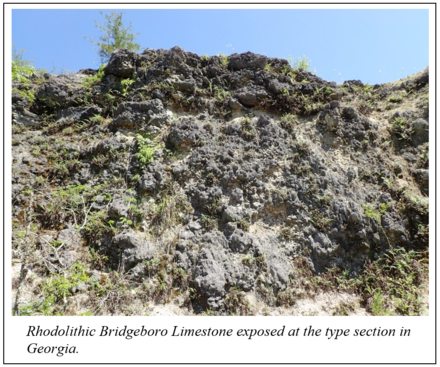
Geologic formations are the basic rock units used in stratigraphy, the branch of geology that deals with the layers of sedimentary rock (called strata) that have accumulated over geologic time.
The lower Oligocene Bridgeboro Limestone was formally named by geologist Paul Huddlestun (1993). The name given to this lithostratigraphic unit comes from the small community of Bridgeboro near the type section in southwestern Worth County, Georgia. This limestone formation is unique in that it contains beds comprised of rhodoliths, which are round, hard nodules comprised of calcium carbonate secreted by red coralline algae. They range in size from less than a half-inch in diameter to as large as five inches in diameter and can be the primary component of the limestone in some places.
The Bridgeboro Limestone was deposited during the early Oligocene (33.9 – 28.1 million years ago). It occurs in southern Georgia and northern Florida along the northern and southern flank of a subsurface feature called the Gulf Trough, which was a paleo-channel that existed from the middle Eocene through the middle Miocene when sea level was much higher than today. A paleocurrent called the Suwannee Current flowed northeast through this channel, much like the modern-day Florida Current, which flows eastward around the southern tip of Florida and north along the east coast of the United States. The Suwannee Current that flowed through the Gulf Trough created the high-energy environment necessary for the rhodoliths to form. The only known exposure of this unit in Florida is in a small limestone quarry near Duncan Church in northeastern Washington County. Huddlestun (1993) designated this as a reference section for the Bridgeboro Limestone.
|
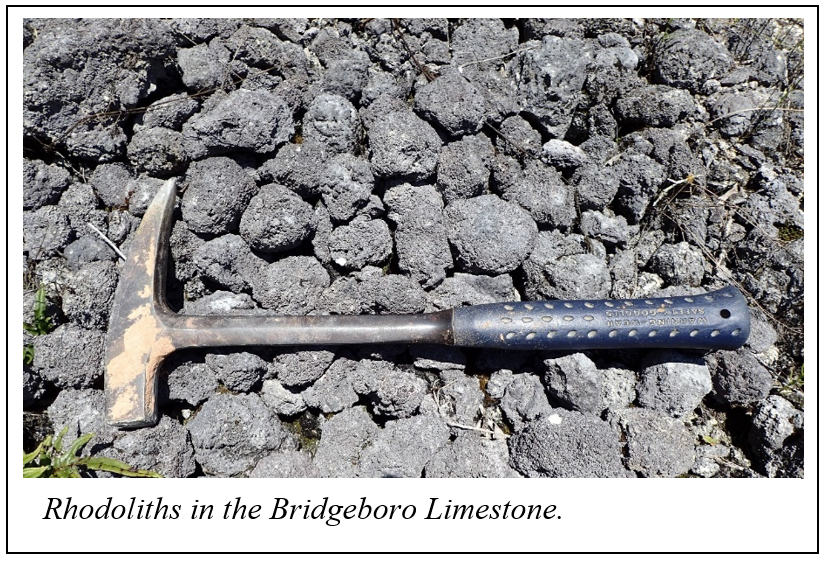
The Bridgeboro Limestone overlies the Marianna Limestone in the Duncan Church quarry and grades laterally into what has been called the Suwannee Limestone away from the Gulf Trough. There have been numerous names applied to the Oligocene limestone units in Florida and South Georgia, but most of the work was based upon the fossil assemblages contained in them rather than the lithology. In addition to the rhodoliths that occur in the Bridgeboro Limestone, other fossils include mollusks, echinoids and foraminifera.
Rhodoliths occur in modern environments in the Gulf of Mexico and other parts of the world, and are an important part of marine ecosystems. In the Gulf, they occur in water depths ranging from ~150 to 300 feet (45-90 meters) and provide hard substrate that numerous marine species use in various ways. Modern environments where rhodoliths occur provide insight into how the ancient rhodolithic Bridgeboro Limestone formed.
References:
Huddlestun, P.F., 1993, A revision of the lithostratigraphic units of the Coastal Plain of Georgia: the Oligocene, Georgia Geological Survey Bulletin 105, 152 pages.
Contact: Harley Means, P.G. Administrator
Back to top
|
by Dr. Jonathan D. Arthur
The smallest supportive act or encouraging statement can change the course of one’s career. Whether you know it or not, you have likely had this type of influence on someone. Think about words that have influenced you. Perhaps the most resonating words for me were “You’re going to make a great state geologist someday.” I wish I could say these words came at a time when I was thoughtfully focused on my long-term career path, but the truth is I was just taking it day by day – trying to complete a big project at work and be a good parent to an 11-year-old. The words came from an internationally renowned geoscientist, Dr. Phillip E. Lamoreaux Sr., after we attended the same meeting. If a statement like that can have a profound influence with only the passing of seconds, think about the potential benefits that could be realized from investing time as a mentor.
Mentoring, simply put, is an interaction between a person who is more experienced and a person who is less experienced. Interactions lead to relationships. The mentor-mentee relationship does not have to be one-on-one; it could be one to many, or many to many (i.e., groups mentoring groups). In addition, the mentoring relationship can be formal or informal, fleeting or consistent, and is generally mutually beneficial. Regardless of where you are in your career, you are a role model to someone. With a little extra effort, you can be an active mentor rather than a passive role model. To a student or a growing professional, having a mentor can make all the difference!
Why is mentoring important? At a basic level, everyone has something to share that would benefit others, and if that knowledge is well-received and shared with care, it’s a win-win! At a broader level, mentoring is a proven model of success for sustainability of scientific professions. We have all heard of STEM, which has been embraced due to a national concern about the sustainability America’s workforce in science, technology, engineering and mathematics. Moreover, we all understand the importance of diversity in the workplace; multiple perspectives yield a stronger foundation and more sustainable results.
Although achieving workforce balance in under-represented groups (e.g., race, ethnicity, gender or socioeconomic level) has been an important goal for quite some time, the geosciences (including the FGS) have a long way to go. For example, a National Science Foundation (NSF) study in 2017 reports that women represent only 23 percent of the overall earth scientist/geologist/
oceanographer workforce. Geoscience B.S. and M.S. degrees awarded reveal an improving picture with approximately 42 percent of the recipients being women (American Geosciences Institute, 2017). Regarding under-represented minorities, the U.S. population is 41.8% non-white (Census.gov), whereas only 19% of geoscience graduate students are non-white, according to 2017 NSF data.
 Innovative advances in geoscience can best be gained from a scientific community with diverse backgrounds, experiences and perspectives. Time you invest in being attuned to another’s career, supporting their path, and offering knowledge and direction is time well-spent. You may find that bright, younger minds around you are influencing you as well. Knowledge, encouragement and support certainly go both ways. I encourage you to be a mentor at some level and help strike a better balance in our workforce. There are many resources online. You, your workplace, the geosciences and the environment will be better for it.
Contact: Dr. Jonathan D. Arthur, P.G.
FGS Director and State Geologist
Windley Key Fossil Reef Geological State Park was designated as a State Geological Site by the Florida Geological Survey because it provides a beautiful exposure of a geological unit known as the Key Largo Limestone. Fossil corals and other ancient marine life are preserved in these rocks and record a unique part of Florida’s geologic history. Visitors to the park can stand inside a fossil reef - the same rocks that comprise the aquifer of the upper Florida Keys.
The Key Largo Limestone is a white to light gray, moderately hard limestone composed of coral heads encased in a matrix of sand-sized grains. These grains are made up of the mineral calcite (calcium carbonate, or CaCO3). There are five primary coral species found within the Key Largo
Limestone: star coral (Montastrea annularis), porous coral (Porites astreoides), and brain corals (Diploria stigosa, Colpophyllia natans, Diploria labyrinthiformis). These corals make up approximately one-third of the limestone. In addition to corals, fossil mollusks and bryozoans are found in the Key Largo Limestone. This geologic unit was deposited in a shallow marine environment. Older (and deeper) parts of the Key Largo Limestone formed in deeper water, whereas the younger limestone formed in shallower and warmer waters and represent patchy coral reefs that are exposed in quarries at the park.
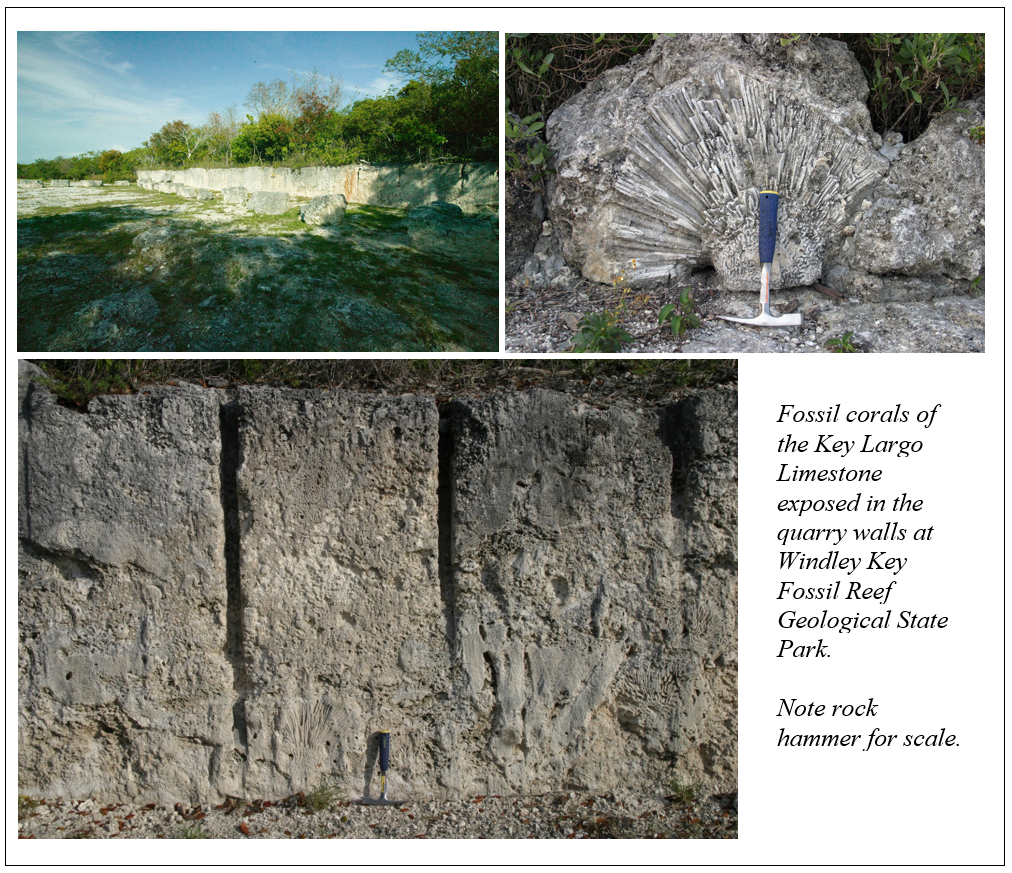 So, if you can stand in a quarry cut within an ancient fossil reef, what does it mean? It means that during the time this reef was alive (just like offshore today), sea-level was much higher. Imagine sea-level being tens of feet above your head as you stand in the quarry. Florida does indeed have a fascinating geologic history!
When you visit Windley Key Geological Site, you will notice layers of red soils, known as terra rossa, within some of the quarry walls. The story behind these soils is fascinating. Over thousands of years, naturally acidic rain water dissolved some of the limestone, leaving behind a residue consisting mainly of African dust that was blown across the Atlantic Ocean and deposited along with the carbonate sediments. Agricultural fields on the Florida mainland west of Miami are named the “Redlands” because of the color added by this dust component. During your visit, be sure to allow time to explore the Allison Fahrer Environmental Education Center, which is full of informative exhibits about the park’s cultural and natural history.
Contact: Harley Means, P.G. Administrator
Back to top
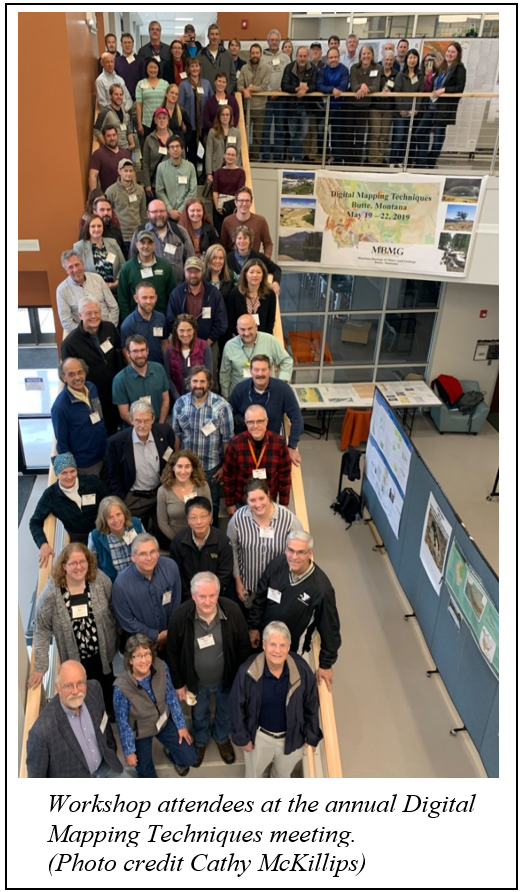
Alan Baker (P.G. Administrator) and Rick Green (P.G., STATEMAP Program Manager) recently attended the Digital Mapping Techniques Workshop in Butte, Montana. This meeting, which has been held annually since 1997, brings together GIS specialists, geoscientists and cartographers from state and federal agencies, universities, the private sector and the international community. Topics of discussion include digital mapping techniques, map publication, GIS analyses, and standardized methods for GIS map production. The workshop provides a unique opportunity for professionals involved in geologic mapping to meet and exchange ideas.
This year’s workshop was hosted by the Montana Bureau of Mines and Geology The workshop's 79 attendees included representatives from 28 State Geological Surveys, the U.S. Geological Survey (USGS), the Bureau of Ocean Energy Management, the Geological Survey of Canada, and the British Columbia Geological Survey. The workshop included a one-day hands-on training session for GeMS (Geologic Map Schema), a standardized map schema developed over the last decade by USGS and workshop members that is designed to create a standardized method for creating digital geologic map coverages. This allows for compilation of geologic map data from different entities for the National Geologic Map Database (NGMDB).
During the workshop, Darcy McPhee, Associate Program Coordinator for the USGS National Cooperative Geologic Mapping Program, presented a talk outlining proposed changes to the USGS STATEMAP program, which included the mandatory use of the GeMS schema for all STATEMAP-funded projects beginning in 2020. In addition, several presentations on using GeMS schema for mapping were given during the workshop. Other workshop presentations included a wide variety of topics such as the use of digital field data collection tools, integrating field data into project or corporate databases, building digital data repositories, the use of Story Maps to present data, and versioning of GIS publications. The workshop also included a “Map Blast” and poster session where attendees were able to view dozens of examples of geologic maps being produced for the STATEMAP program, as well as several posters outlining methodologies for geologic mapping and GeMS implementation. Meeting attendees had the opportunity to tour the Berkeley Pit, a former open-pit copper mine that produced over 320 million tons of ore between 1955 and 1982.
Contact: Rick Green, P.G. III
Back to top
|

The beginning of the fiscal year is a bittersweet time for the Florida Geological Survey as staff bid a fond farewell to Dan Phelps, P.G. After 17 years with the FGS and 29 years with the State of Florida, Dan is retiring to pursue hobbies and new projects.
Dan is known as a true public servant with a willingness to assist any member of the public with care, patience and professionalism. With Dan's vast experience as a geophysicist and professional geologist, his work has been invaluable to many geological research projects at the FGS, including the Florida beach sediment analysis and characterization of offshore mineral sands for beach nourishment.
Dan earned a B.S. in Geology at Campbell University and two Master of Science degrees – one Master of Geology degree at Duke University and a master’s in environmental management from University of Houston – Clear Lake. For 12 years, he conducted oil and gas exploration projects and served as a geophysics consultant. Dan served as the senior on-board marine survey geophysicist responsible for quality control in the collection of geophysical data in the Gulf of Mexico and Bering Sea. He analyzed data from tools including sub-bottom profilers, side-scan sonars, and magnetometers. Dan also worked as a physical scientist for the U.S. Army Corps of Engineers Coastal Engineering Research Center where he implemented a geophysical research project to locate quality sands for beach restoration.
Dan joined the Florida Department of Environmental Protection in 1990 and worked for the department’s Southeast District as an environmental specialist until he was promoted into a professional geologist position in 1995. During this time, his duties included oversight of contamination assessment and ensuring remediation efforts met with regulatory compliance standards. While he worked for the Underground Injection Control (UIC) team, he reviewed permit applications for various injection and monitor-well systems.
In 2002, Dan joined the FGS team and for the next 17 years he conducted advanced geologic work, including evaluation of geologic interpretation and co-authoring and reviewing several scientific publications. Dan served as an onboard marine-survey geophysicist when conducting offshore research projects, assisted with various research projects using vibracoring and side-scan sonar data collection, provided countless presentations over the years to various organizations and groups, and took an active role in the FGS outreach and education program.
From a professional standpoint, Dan has been a true public servant. On a personal level, he has been a delight to work with, and FGS wishes him success, happiness and good health in his retirement.
Contact: Sarah Erb, Operations Manager C
Back to top
|
|